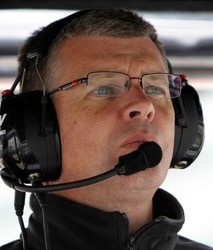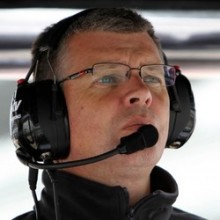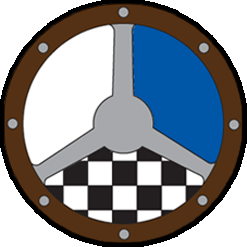Ask a pro
Receive advice directly from today’s top stars
Design/race engineer Iain Watt, who has enjoyed success in open-wheel, stock cars and sports car racing, is now accepting questions as the newest Online Engineering Instructor. His answers will be posted beginning Monday, February 24.


Iain Watt
2014 Rolex 24 At Daytona Race-winning Engineer
Iain Watt is certainly no stranger to world-class drivers. The Scottish-born engineer has worked with a who’s who of open-wheel stand-outs, including Max Papis, Cristiano da Matta, Dario Franchitti, Christian Fittipaldi and Tony Kanaan. He also played a prominent role in Action Express Racing’s victory in the 2014 Rolex 24 At Daytona, the opening round of the new TUDOR United SportsCar Championship.
A graduate of the Cranfield Institute of Technology in Bedford, England, Watt gained his first experience of open-wheel racing with Lola Cars Ltd., where he worked between 1994 and 1996 as Design Engineer of the Indy car project and served as race engineer with a number of teams during the season. Watt then grasped an opportunity to move to the United States with Precision Preparation, Inc. (PPI). He worked as track and in-house chief engineer for the team’s Champ Car program, overseeing da Matta’s first victory at Chicago Motor Speedway in 2000. After successful spells also with Team Green and Mo Nunn Racing, Watt joined Cheever Racing in 2004, taking engineering responsibility for both the team’s IRL program and, in 2007, a redesign of the Fabcar sports car chassis.
Watt continued to broaden his experience by switching to NASCAR, where he worked as Performance Engineer for Gillett Evernham Motorsports and Richard Petty Motorsports for three years before reverting to the sports car ranks with Action Express Racing where he has played a key role in helping the team return to Victory Lane.
Iain Watt answers your questions!
-
Mason McGinty
I currently race karts in the Rotax Junior series. As an aspiring race engineer myself, how did you come to first get noticed at Lola Cars Ltd.?




Before I joined Lola I worked as a data engineer at Leyton House March Racing. It’s not really about getting noticed; it’s more about getting started somewhere that allows you to grow, learn and make connections.
-
Xavier Hollande
How much do you change the race car’s settings between qualifying and the race? Would the answer be different for sports cars, NASCAR and Indy car?




It all depends on the series. In sports cars we do a few things but qualifying is often the first time the driver will get clear laps without traffic. In NASCAR the teams change many things to optimize the car for qualifying with the majority being in reaction to the large center of pressure migration you get when you tape the front of the car up. In IndyCar you have different grip levels from different compound tires to deal with, so it really depends on the series. The other factor to consider is how important is qualifying? We typically don’t waste much time at Daytona preparing for qualifying as the race is so long. For shorter races we pay more attention to qualifying.
-
Jacob Eidson
I’m currently racing in the USF2000 series and trying to gain as much knowledge as I can about the engineering aspect of racing for several reasons, one being that if racing doesn’t work out as a career I could pursue becoming an engineer. In your opinion do you think it’s mandatory to get a college degree in engineering to become a racing engineer?




Not at all. Having a degree will help open doors, so don’t give up on your education, but many of the smartest people I have had the pleasure of working with are not necessarily book smart but have found through experience and logical thinking the answers to the engineering problems.
-
Terry Jones
Do you believe that a tubular frame is as safe – or can be as safe? – as a modern carbon tub?




Racing cars are inherently dangerous. I understand your question but it all depends on the series rules that the cars are made to comply with. I have seen carbon tubs fail and the rules subsequently changed to deal with a particular problem and the same can be said for tube frame cars. The governing body of any race series will hold safety at the top of their list of priorities and should actively pursue changes and test methods to improve both driver and spectator safety. The basics of deceleration rates, intrusion and restraint systems apply to ether type of chassis.
SAFEisFAST.com Video: Evolution of Safety
-
Jack Thomas
Do many race teams have internships/coops for college level students? How much does FSAE matter?




Most bigger teams and manufacturers have internships. It’s difficult with smaller teams as they don’t have the resources to get entry level students started. FSAE is a great way to get involved in motorsports and gain some experience, but I would say it’s not a mandatory step either.
-
Martin Lord
Can you ever make a chassis stiff enough?




Yes. In NASCAR, for example, the front of the car can be considered a spring and its compliance has to be taken into effect. If the car is too stiff the tire will not work optimally. Also there are physical limitations and regulations that stop you softening the car beyond a certain point, so allowing the chassis some deflection is a good thing. In most other series the “stiff chassis is better” principle applies.
-
Brandon Welsh
I have a front-wheel drive car that has a 90-inch wheelbase, about 190 hp and weighs about 2150lbs with me in it. When I get on the brakes hard, the rear of the car feels light and will sway. I’ve even entered corners counter steering or lost control entirely. I designed a diffuser that helped but when braking from 110mph plus it can still get light in the rear. I’ve replaced brakes, master cylinder, booster, and so on to try and fix it. What ideas do you have to correct this issue I’m having?




It’s hard to say without knowing your car. It could be as simple as you have too much brake bias to the rear or you need to try more rebound in the rear, or could the front be just too soft? Keep trying and you will figure it out.
SAFEisFAST.com Video: Basic Chassis Setup 2
-
Arthur
You always hear about how important car setup is around an oval. How true is that? What major differences do you find coming from a road course going to a place like Indy?




The car setup is always important, although in general on road tracks the driver can control more factors and have a bigger effect. On ovals the setup is just as important but the driver has less options. Both disciplines require skilled drivers who are tuned in to what makes the car work and what they want from the car. In short, on either road tracks or ovals it’s hard for a driver to be fast if the car is not set up well.
-
Markus
Hey Iain, I would be interested in your opinion about what kind of soft skills engineers should bring with them to be interesting for racing teams? I’d also like to know if you think that passion and motivation for racing are equally or even more important to the teams than pure education? Lastly, if you can recommend (advanced) books or literature for engineers? Thank you.




You can usually tell when you meet someone if they have a passion and enthusiasm for something. Racing is no different than most subjects; to be good at anything you will need more than good grades to be successful. It is hard to recommend any books as there are so many good ones.
-
Mark
When working with a brand new race car, how do you come up with a starting setup? Are there general things that every car likes?




Well, it all depends on how much information you have on the car. Typically, you start off quite cautiously and build up from there. You usually know a little about the tires, aero and mechanical properties of the car so you start with the ride heights on the high side so you don’t grind the bottom of the car off, etc., and you progress from there if you have limited knowledge. If you have more information you will use a combination of simulation and experience to help make more accurate decisions with regard to starting setup.
SAFEisFAST.com Video: Basic Chassis Setup 1
-
Edward
Where do you get the best aero information from – the wind tunnel or from CFD?




The race track gives the best information overall. Wind tunnels and CFD are great tools but many a race car has been a disaster due to poor aero performance. You can break down aero data into two categories, data that is used during the car’s design period and race track data like ride height maps for various car configurations that is used in setup optimization. CFD has pretty much taken over in the design world with wind tunnels being used more for verification purposes.
-
Jack Mitchell Jr.
Which was your favorite series to engineer? What were the main differences between working with a NASCAR and a sports car team?




I liked NASCAR a lot as you got to race every weekend and despite the apparent lack of technology I can assure you that there are many clever crew chiefs and engineers working in that series. All racing is fun to me, and my current job in sports cars gives me the opportunity to work with a great group of guys and really good drivers. There are only 15 of us at Action Express so communication is easier than in the NASCAR world where teams tend to be much bigger.
-
Cody Gale
Everyone talks about how important communication is between a driver and engineer. What kind of feedback do you look for in a driver to help you best understand how the car is handling?




Firstly, it needs to be accurate, but also the driver needs an understanding of how hard to push the car without over-driving it. It’s easy to brake super-late, for example, but it compromises the corner exit and is often slower than backing up the corner and getting back to throttle earlier. Good drivers understand this and can change or adapt to get the most out of the car.
SAFEisFAST.com Video: Working With an Engineer
-
Sandy Gibson
What is your take on the new Formula 1 regulations? Is that the way F1 needs to be going? We have all become so used to the remarkable reliability of F1 cars over the last few years, and now – in testing at least – they seem barely capable of completing a race distance! Is there too much technology now?




For sure there is some interesting stuff going on in F1 and some teams are struggling with reliability and how much running they get in testing. It wasn’t that long ago when it seemed unthinkable for an F1 car to make a single engine last a whole race weekend let alone more than one race weekend.
With regard to technology and the number of changes for this year, F1 has always been an arena for sport and technology to meet. Not many racing series have embraced energy recovery like F1, mostly because of budgetary constraints. Most series make small changes or adjustments to their rules during or at the end of the season, and usually after a few years of small adjustments there are bigger changes that redirect the series. F1 is dealing with that now. Give it a few races and the good teams will have fixed their issues.
-
James Swinbanks
Hi Iain, I wanted to ask, how much does the wind actually affect the handling of an Indy car, or any open-wheeled, high-downforce car? Can it completely ruin the balance of a car?




It’s definitely a factor. Apart from the obvious of the wind blowing dust or sand onto the track, most tracks have a wind direction that is favorable for lap time and the opposite wind direction often hurts lap time. For example, at Daytona on the road course the wind usually blows you into Turn One so you have a tailwind all down the front straight. You lose a little due to the headwind on the back straight but the wind on the front of the car helps the car through the bus-stop chicane and the lap time is usually better. If the wind turns around through 180 degrees and you have a head wind on the front straight, it can slow the car down by 0.5 to one second quite easily. It’s not so much that the car’s balance is ruined but it is changed a little at some critical corners thus changing the lap time.
-
Nick Sarton
I’m studying at Clemson University in South Carolina for mechanical engineering. I love racing and I have been trying to get into it more. I was wondering how does someone go about getting on a race team as an engineer?




All race teams will recruit junior engineer positions at some time or have some form of internship program where the team gets to meet and evaluate possibilities for future employment. We (at Action Express Racing) currently have a student from the motorsports program at UNC Charlotte who works with us one day per week.
SAFEisFAST.com Video: Becoming a Race Engineer
-
Tristan Nunez
Out of all the years you have been involved in motor sports, what was the most confusing car to learn? And why?




Great question. Having worked primarily in open-wheel and sportscar it was very interesting to work in NASCAR. Yes, it was confusing at first. I personally think NASCAR racing is very misunderstood in the open-wheel/sportscar world in terms of the way you work with the car. The rules and the racing are all carried out in a very different manner to the open-wheel/sportscar world. Every racing series has evolved down its own path with rules and regulations that are in place based on a mixture of tradition, performance limitations, safety measures and cost containing measures of some kind. But at the end of the day it’s about getting your driver/car combination ‘round the race track to the checker flag faster than the opposition within the given rules. Every series or type of race car has its own important factors that in another series can be quite insignificant and vice versa. Usually if there is any confusion it’s because all the factors that are in play have not been figured out.
-
Albert Ross
As an engineer, once you find a good set up with one driver, how much do you find that might change with other drivers, if at all?




Usually, changes that make the car better for one driver make the car better overall and the other drivers find it better when it is their turn to drive.
-
Ross K
I am a 17-year-old high school student and I am trying to decide what I want to do when I go to college next year. I have already applied and gotten in to most of the universities that I am interested in but I am having trouble deciding where I want to go. I have always had a passion for cars and motorsports and it would pretty much be a dream job to become a race engineer like you. The main thing that I am wondering is whether you think it would more beneficial for me to attend a good, more well-known university with a regular mechanical engineering program (something like Michigan State University) or a less prestigious and less well-known school that has a mechanical engineering major and a motorsports engineering minor (like Old Dominion University)? Do employers consider the quality of school that you attended in addition to the degree/s that you’ve earned or are they more concerned with the degree/s? Any assistance is greatly appreciated.




Having good grades is very important. Having good grades in a recognized engineering school is better, but only if they come from a person that has good common sense and a balance between the practical and theoretical worlds.
SAFEisFAST.com Video: Finding a Career in Motorsport
-
Duncan Charnell
What would you rather have – a ramp diff or a viscous diff?




Usually, a viscous or combination viscous/plate differential will be better than a pure plate diff as it offers some cushioning against torque spikes from curbs, etc. Another advantage is the speed-sensing characteristics of the viscous diff compared to the torque-sensing properties of the plate diff. Thus, the plate-type diff has a somewhat fixed characteristic with speed whereas a viscous diff changes with speed and will tighten up as one wheel spins, rather than spin based on the amount of slip that has been preset into the plate type diff with the ramp angles and freeplay/preload on the plates. The differential we use in the DP car has to be a “plate type” diff by regulation, with viscous units being illegal even though they show performance advantages in other cars and series.
-
Jack Mitchell Jr
From an engineering standpoint, what is the best way for a driver to maximize testing and/or practice? Thank you for your time!




Understanding the test objectives is important as a driver. We always have a plan for how the test or practice session is going to go. This helps us manage the track time available and helps keep everyone on the same page.
-
Joey Bickers
Do you have any advice for a driver who is still learning how to “feel” a car mechanically? I want to be able to give better feedback about the car to improve its setup.




Don’t be scared to make changes to your car. Just make sure you can change things back if the thing you are trying does not work. This way you will know what happens when you do changes rather than having to guess. For example, softer springs may feel better in a slow-speed section of the track but may make the car feel unsupported and move too much in a faster section of the track. You then can either compromise and go somewhere in the middle or say, let’s try a bigger anti-roll bar rate to support the car better in higher load corners.
SAFEisFAST.com Video: Working With an Engineer
-
Hunter M
What type of classes should I take in school to better prepare me for becoming a design engineer?




Having a good base in mechanical engineering will never let you down in my opinion.
-
Wil
Iain, thanks for your willingness to share your knowledge. I’d like to ask whether or not you use performance metrics such as the “stability derivatives” and the like, when performing analyses of the car. I’m specifically curious about yaw natural frequency and damping, directional stability and stability factor. Thanks once again, best wishes for a great season.




Yes, we use performance metrics and other analysis techniques. The yaw natural frequency is not really changeable as the car layout and suspension are all homologated and are thus almost fixed. We can, however, change aero loading, center of gravity location, etc., within a window which allows us to optimize some of the parameters you mention. Usually we are limited by a lack of information and this unfortunately limits the level of calculations we can perform. For example, tire data is not hard to generate but many racing series ban teams and manufacturers from generating the data, so sometimes you end up using old data from a time before the testing ban and have to accept the limitations.
-
Marc Rennen
Hi Iain, I am now studying Automobile Engineering in Germany and want to step into the racing world. Unfortunately, there is no Formula Student Team in our university so I have to learn all the racing stuff by myself. I have been to many races like WEC, DTM, VLN etc. I would like to ask you which category do you think is better to start with as a newcomer, open-wheeler or sportscar racing? I am personally a sportscar fan, but I know the limit of formula car is much higher, especially when talking about the downforce level. Do you feel the lack of know-how on non-downforce cars like GTs will hurt a lot for the future career?




Any racing experience is generally good and will help your career plans. Every racing class or series has its own idiosyncrasies, thus understanding them and optimizing within the rules is what’s important.
SAFEisFAST.com Video: Becoming a Race Engineer
-
Tom Ecklein
I have been a fan of road racing since the mid 1960s and love the competition side. However, I also enjoy trying to understand the technical and engineering side too. Do you have any recommendations as far as good books or publications for the lay person to get a better understanding of suspensions and how the components effect handling? Thanking you in advance, Tom.




“Tune to Win” by Carroll Smith has been out for years and remains one of the best resources, but there are many other ones also that will cover the same subject.
-
Paolo
If DPs were allowed to race in Le Mans, what would be the biggest challenges you would face in terms of setting up the car? How much different would it be compared to, say, Daytona?




Good questions. Whenever we go to a new track we have certain questions that have to be answered — for example, what aero setup is best for the track? We can answer many questions through simulation and gain insights into other questions again through simulation. However, things like actual brake wear are important to quantify so you need to be able to answer questions like, “does the car have the correct brake setup?” Another level of questions are items such as lights. At Daytona the ambient lighting is such that you can drive the car without headlights. Le Mans is very different, thus an item that is relatively unimportant at Daytona becomes a very important item at a different track.
-
Trina Burke
How do you feel about the upcoming electric racing movement? Do you see any potential with running cars with no loud engine noise?




I think it’s pretty exciting. Sure, the cars will sound different with no exhaust noise, but the same could be said when Audi went diesel; the exhaust note changed and the tire noise became more dominant. The technology application will be very interesting. Formula E will get the ball rolling in a slightly different direction to previous electric race car projects. The quest for more efficient powertrains will very much depend on the rules that the various sanctioning bodies make and how open they are to what some consider unconventional thinking.
-
Dan Stokes
What was the biggest challenge you faced as an engineer going from GRAND-AM to the Tudor SportsCar Championship?




I would say adapting to the new rules package for DP cars and then applying them to race tracks that are new to Daytona Prototype cars. It was good to start at Daytona where we know the track and then just have to deal with new parts and rules, compared to a track like Sebring, for example, where we have limited knowledge for our car.
-
Nathan Laverdure
Did you originally want to be a race car driver or was your main mind set to be an engineer? What are some of the goals you set for yourself to become one of the best in the business?




I raced Formula Ford for a few years, some of them whilst I was studying engineering. I would say I was an average race car driver…and also a penniless one which then pretty much ended any driving ambitions I had.
 Road Racing Drivers Club
Road Racing Drivers Club
 Share
Share







